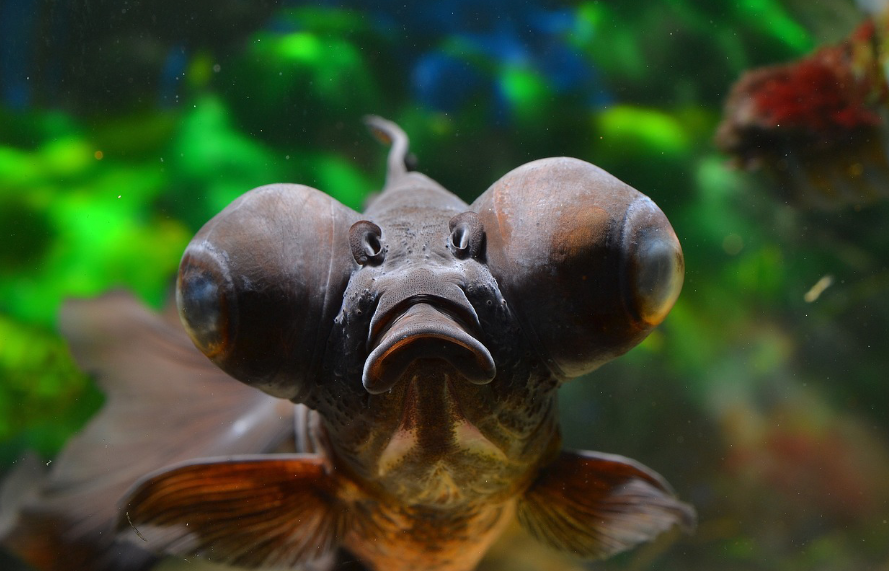When it comes to ornamental fish, the black moor goldfish stands out from the crowd with its unique and mesmerizing appearance. With its velvety black color, protruding eyes, and flowing fins, this fish has captured the hearts of fish enthusiasts around the world. In this comprehensive guide, we will delve into the fascinating world of the black moor goldfish, exploring its history, physical characteristics, care requirements, and more.
History and Origin of the Black Moor Goldfish
The black moor goldfish has a rich history that dates back to ancient China. It is believed to have originated from the selective breeding of the telescope goldfish, which is known for its protruding eyes. Over time, breeders focused on developing a black variety of the telescope goldfish, resulting in the creation of the black moor goldfish we know today.
Physical Characteristics and Unique Features of the Black Moor Goldfish
One of the most striking features of the black moor goldfish is its velvety black coloration. Unlike other goldfish varieties, the black moor lacks the metallic or bright colors typically associated with goldfish. Its deep black color gives it an enigmatic and mysterious allure.
The black moor goldfish is also known for its unique physical characteristics. Its body shape is round and chubby, with a short and stubby tail. The most distinctive feature of the black moor goldfish is its protruding eyes, which give it a cute and endearing appearance. These eyes are delicate and require special care to prevent injury or infection.
Black Moor Goldfish Care Requirements
To ensure the health and well-being of your black moor goldfish, it is essential to provide proper care and maintenance. Here are some key care requirements to keep in mind:
Tank Size and Water Parameters
Black moor goldfish thrive in spacious tanks that provide ample swimming space. A minimum tank size of 20 gallons is recommended for a single black moor goldfish, with an additional 10 gallons for each additional fish. It is important to maintain stable water parameters, including a temperature range of 65-75°F (18-24°C) and a pH level between 6.5 and 7.5.
Filtration and Oxygenation
Due to their delicate eyes, black moor goldfish are prone to poor eyesight and impaired vision. To ensure optimal water quality, a reliable filtration system is crucial. Additionally, providing adequate oxygenation through the use of air stones or aeration devices will help maintain a healthy environment for your fish.
Tank Decorations and Substrate
When decorating The Goldfish Tank for your black moor goldfish, it is important to consider their delicate fins and eyes. Avoid sharp or rough decorations that could potentially injure them. Smooth rocks, live plants, and soft substrates are ideal choices. The addition of hiding spots and caves will also provide your black moor goldfish with a sense of security.
Setting up the Perfect Tank for Black Moor Goldfish
Creating an ideal habitat for your black moor goldfish is key to their overall well-being. Follow these steps to set up the perfect tank for your fish:
Step 1: Choosing the Right Tank
Select a tank size that meets the minimum requirements mentioned earlier. Ensure that the tank is made of high-quality glass or acrylic, with no leaks or cracks.
Step 2: Setting up the Filtration System
Install a reliable filtration system that can handle the tank’s water volume. Choose a filter that provides both mechanical and biological filtration to keep the water clean and free from harmful ammonia and nitrate levels.
Step 3: Adding Substrate and Decorations
Add a layer of soft substrate to the bottom of the tank, such as sand or rounded gravel. This will provide a natural environment for your black moor goldfish. Carefully place smooth rocks, live plants, and other decorations to create a visually appealing and safe environment.
Step 4: Cycling the Tank
Before introducing your black moor goldfish to the tank, it is crucial to cycle the tank. This process establishes a beneficial bacteria colony that helps break down harmful waste products. Use a water testing kit to monitor ammonia and nitrate levels during the cycling process.
Step 5: Introducing Your Black Moor Goldfish
Once the tank is cycled and the water parameters are stable, carefully acclimate your black moor goldfish to their new environment. Slowly introduce them to the tank by floating the bag they came in and gradually adding small amounts of water from the tank. This will allow them to adjust to the temperature and water chemistry.
Feeding the Black Moor Goldfish
Proper nutrition is essential for the health and vitality of your black moor goldfish. Here are some important factors to consider when feeding your fish:
Diet and Feeding Schedule
Black moor goldfish are omnivorous and will benefit from a varied diet. Offer them a combination of high-quality commercial fish pellets or flakes, as well as fresh vegetables and occasional live or frozen foods. Feed your black moor goldfish small amounts multiple times a day to prevent overfeeding and maintain water quality.
Avoid Overfeeding
Overfeeding can lead to obesity, poor water quality, and health issues. Only feed your black moor goldfish what they can consume within a few minutes. Remove any uneaten food to prevent it from decomposing and polluting the tank.
Consideration for Eye Health
Due to their protruding eyes, black moor goldfish may have difficulty locating food. Consider using sinking pellets or flakes to ensure they have enough time to locate and consume their food. You can also use feeding rings or target feeding to direct the food towards them.
Common Health Issues and How to Prevent Them in Black Moor Goldfish
While black moor goldfish are generally hardy, they can be prone to certain health issues. By understanding these common ailments and taking preventative measures, you can ensure the well-being of your fish:
Swim Bladder Disorders
Swim bladder disorders can cause buoyancy issues in black moor goldfish, making it difficult for them to maintain their balance in the water. To prevent swim bladder disorders, avoid overfeeding and provide a balanced diet. Avoid feeding your fish foods that are high in carbohydrates, as these can lead to bloating.
Eye Infections and Injuries
Due to their protruding eyes, black moor goldfish are more susceptible to eye infections and injuries. Maintain clean water conditions and avoid rough or sharp decorations in the tank. If you notice any signs of eye infection, such as cloudiness or redness, consult a veterinarian specializing in fish health.
Temperature Fluctuations
Black moor goldfish are sensitive to temperature fluctuations, which can stress them and weaken their immune system. Ensure that the tank is kept at a stable temperature within the recommended range mentioned earlier. Avoid placing the tank near drafty areas or direct sunlight.
Breeding Black Moor Goldfish
Breeding black moor goldfish can be a rewarding experience for fish enthusiasts. However, it requires careful planning and preparation. Here are some important factors to consider when breeding black moor goldfish:
Selecting Breeding Pairs
Choose healthy adult black moor goldfish as breeding pairs. Look for individuals with desirable traits, such as deep black coloration, well-proportioned body shape, and symmetrical fins. It is best to keep the male and female separate until you are ready to initiate the breeding process.
Creating a Breeding Tank
Set up a separate breeding tank with appropriate water parameters and temperature. Provide spawning mops or artificial plants for the female to lay her eggs on. Ensure that the tank is well-filtered and oxygenated.
Spawning and Rearing Fry
Introduce the male and female into the breeding tank and closely monitor their behavior. Once the female lays her eggs, remove the adult fish to prevent them from eating the eggs. The eggs will hatch within a few days, and the fry will need to be fed a diet of infusoria or commercially available fry food.
Fun Facts and Myths about Black Moor Goldfish
Black moor goldfish have captivated people’s imagination for centuries, leading to various myths and misconceptions. Here are some fun facts and myths about black moor goldfish:
Myth: Black Moors Bring Bad Luck
Contrary to popular belief, black moor goldfish do not bring bad luck. In fact, they are considered symbols of good fortune and prosperity in some cultures.
Fact: Black Moors Can Change Color
While black moor goldfish are known for their black coloration, they can change color to some extent depending on their environment and diet. Factors such as water quality, lighting, and food can influence the intensity of their black color.
Myth: Black Moors Are Fragile
Although their delicate fins and protruding eyes may give the impression of fragility, black moor goldfish are actually quite hardy and resilient. With proper care and maintenance, they can live long and healthy lives.
Conclusion
The black moor goldfish is a truly enigmatic and beautiful fish that adds a touch of elegance to any aquarium. By understanding its history, physical characteristics, care requirements, and breeding process, you can provide the best possible care for your black moor goldfish. Remember to maintain stable water parameters, provide a suitable tank setup, and feed them a balanced diet. With proper care, your black moor goldfish will thrive and bring you joy for years to come.



